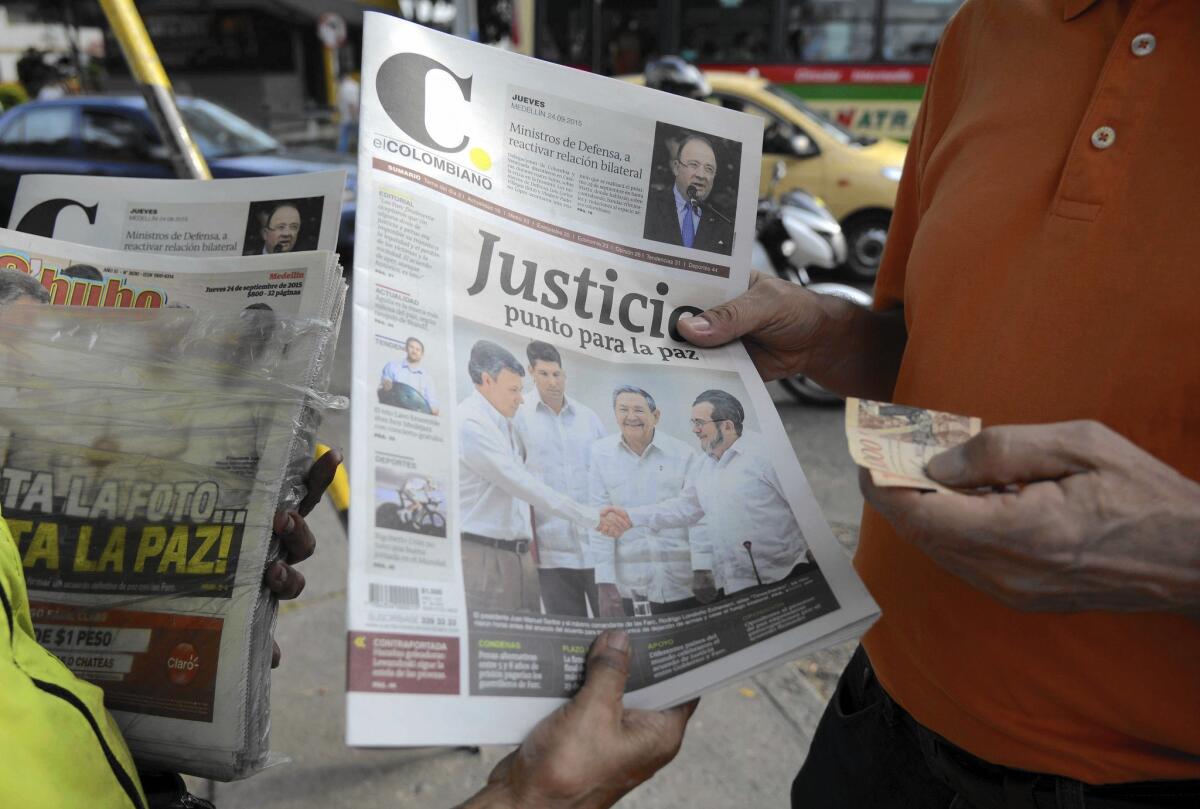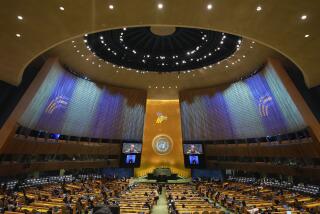Many details remain as Colombia and FARC rebels move toward peace

- Share via
Reporting from Bogota, Colombia — After years of negotiating, the government and rebels in Colombia have passed a major hurdle: Defining the broad outlines of how justice will be given to those who suffered through 50 years of warfare and setting a target date of March 23 for a final peace accord.
Now they must focus on the complicated details of implementing an agreement ending the five-decade conflict and selling it to the Colombian people. That may not be an easy task given the public’s low regard for the rebels of the Revolutionary Armed Forces of Colombia, or FARC, and the likelihood that the final agreement will allow guerrilla leaders to avoid jail terms.
Unanswered questions from the initial accord announced Wednesday in Havana include where FARC members will be concentrated before their integration in society; how the disarming of the fighters will proceed and under whose supervision; and how the country will finance the enormous cost — estimated at $30 billion or more over a decade — of demobilizing rebels, building promised rural infrastructure and paying restitution to victims.
More than 7 million Colombians have applied for compensation as victims of the conflict dating to 1964. Many are among the 5 million who have been internally displaced as a result of the fighting and attendant drug trafficking and extortion. Family members of the estimated 220,000 Colombians killed during the war have also applied for restitution.
Also to be fleshed out are the conditions under which leaders of both the rebels and the armed forces accused of committing crimes against humanity would be tried by special tribunals and detained if convicted. In announcing agreement on the justice clause Wednesday night, President Juan Manuel Santos said only that those admitting their crimes would be sentenced to serve time in “areas of restricted liberty.”
NEWSLETTER: Get the day’s top headlines from Times Editor Davan Maharaj >>
Among those warning of possible impunity for those who committed atrocities was Human Rights Watch director Jose Miguel Vivanco. He cautioned Thursday that the initial agreement as described by Santos could permit those culpable of war crimes to “avoid spending a single day in prison.”
“Some of the most problematic details include how to integrate the tribunal in such a way as to guarantee the legitimacy of its decisions,” said Arlene Tickner, a professor at University of the Andes in Bogota. “How will the maximum [criminal] responsibility of both the guerrillas and the military will be dealt with?”
The process of formally approving a final deal was not defined by the announcement Wednesday at talks in Havana and promises to be a ticklish issue for Santos, who is reluctant to place it before voters in a plebiscite, preferring instead a “little congress” that would be easier to control.
The pace and efficacy of the accord’s implementation, which will include financial and educational aid for rebels reentering society, will be crucial to insure maximum participation, said Adam Isacson, a Colombia analyst with the Washington Office on Latin America think tank in Washington. The number of guerrillas, urban militia fighters and family members may total 30,000 or more, he said.
Integrating the demobilized insurgents is important to keep them from resorting to drug trafficking and other illegal activities, as did many in the ranks of paramilitary groups who refused to participate in a 2006 demobilization. The possibility of former rebels forming criminal bands is said to be one of the biggest post-conflict concerns of the U.S. government.
“The time between the signing of the final accord and when the Colombian government and the international community will be set up to implement it will be a tense period, a time of limbo, that you want to be as short as possible,” Isacson said. “For that, implementation laws will have to be passed quickly after the deal is signed in March.”
Colombians probably would vote to back the general terms of a peace agreement, but the approval of the all-important implementation details might better be left to a smaller representative assembly, Isacson said.
“It could turn out to be the ultimate ‘fast track’ procedure and prove to be a better alternative to giving the president discretionary power or submitting the plan to the full Congress under the usual debate and review process, which will take too long,” Isacson said.
Government and FARC negotiators on Oct. 1 will return to Havana to complete work on the overall agreement as well as address the myriad implementation details.
“Now is the time to take advantage of this opportunity,” lead government negotiator Humberto De La Calle said Thursday at a news conference in the Cuban capital. “We can start counting the days before we have peace.”
Vanda Felbab-Brown, a global security expert at the Brookings Institution, said the true test of whether Colombia becomes a “model of social transformation” won’t come until after the hoped-for March 23 signing of a peace deal.
“It remains to be seen whether Colombia will seize the chance or waste it, letting the countryside fester once again and letting the new peace mask persistent exclusion and marginalization,” Felbab-Brown said.
Kraul is a special correspondent.
ALSO
Protesters in Mexico attack government office over missing students
Pope Francis marks a personal anniversary in eastern Cuba
Colombian navy is waging ‘a battle of wits’ with cocaine smugglers
More to Read
Sign up for Essential California
The most important California stories and recommendations in your inbox every morning.
You may occasionally receive promotional content from the Los Angeles Times.










